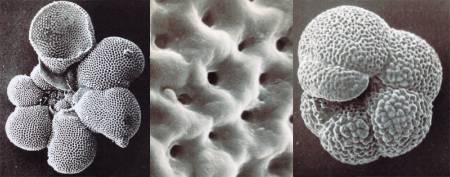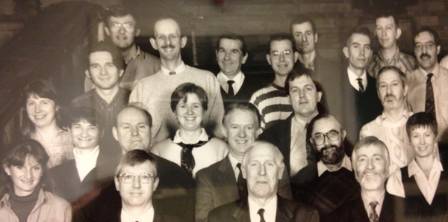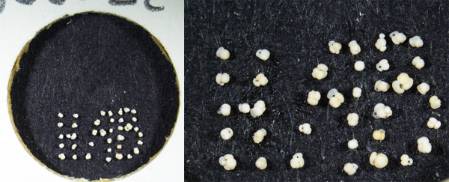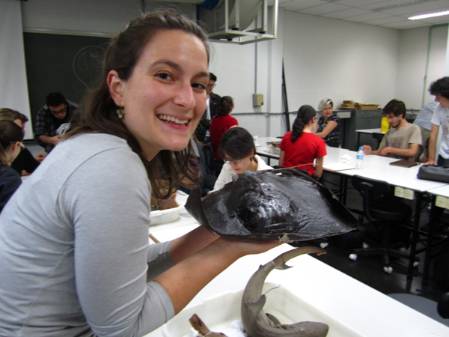Last month we welcomed our new student Marina Rillo, who is studying for a PhD on the evolution of planktonic foraminifera. The collection she is studying is very relevant to climate and oceanic studies and was compiled by the inspiring Henry Buckley, a curator in the former Mineralogy Department.
This post outlines how the collection was made, Marina's project and why the study of planktonic foraminifera and our collections are very relevant.
What are planktonic foraminifera?
Foraminifera are a class of protists (single celled organisms) that are characterised by granular ectoplasm. They are almost exclusively marine but also occur in freshwater and brackish enviroments.
The species Globorotalia (Clavatorella) oveyi (left) was originally described by Henry Buckley in 1973 and named after one of my curatorial predecessors, Cameron D. Ovey.
The name is derived from the term foramen or opening as each shell or test has one or many openings. All planktonic foraminiferal tests are composed of calcium carbonate, but benthic varieties can have shells made of agglutinated sediment and others are naked, ie composed completely of organic material.
The inspiring Henry Buckley
Henry Buckley was a curator in the Museum's Mineralogy Department for much of his life and died in 2002 shortly after his retirement. His curatorial work focused on the Ocean Bottom Deposits (OBD) Collection, and he developed a research interest in the taxonomy of planktonic foraminifera.
Part of the 1999 Mineralogy Department photo displayed in the Mineralogy corridor beneath Waterhouse Way, known to staff as the 'Miner-alley'. Henry Buckley is the smiling character wearing a tie in the middle on the back row.
The OBD Collection consists of samples from some 40,000 locations worldwide and is the most comprehensive British collection of seabed samples and cores, with all the world's oceans represented. The Sir John Murray Collection, which includes the HMS Challenger 1872-76 sea-bed samples, was given to the Museum by the Murray family in 1921 following his death in 1914 and forms the most significant part of the collection.
Slide from the Henry (Alexander) Buckley collection, where he formed his initials from specimens of Globigerinoides ruber (Image by Giancarlo Manna).
Despite the fact that he was actively discouraged by his managers in the Museum from carrying out work as a micropalaeontologist, Buckley amassed an amazing collection of 1,500 slides of individual species of planktonic foraminifera that he extracted from over 260 samples from the OBD Collection.
He published relatively little on the planktonic foraminifera but was a pioneer of scanning electron microscopy, leaving a collection of over 10,000 scanning electron micrographs of planktonic foraminifera with the collection. He was also one of the first to publish on the relationship of seawater to the composition of foraminiferal tests.
- Shackleton, N J, Wiseman, J D H, Buckley H A (1973) Non-equilibrium isotopic fractionation between seawater and planktonic foraminiferal tests. Nature 242, 177-179. doi:10.1038/242177a0
Why planktonic foraminifera collections are relevant
Because planktonic foraminifera secrete calcium carbonate directly from the sea water in which they live, their isotopic composition can give an indication of the isotopic composition of the oceans at the time. The ratio of oxygen isotopes 16O to 18O in sea water is a very good indication of past climate. A higher abundance of 18O in calcite is indicative of colder water temperatures, since the lighter isotopes are preferentially stored in ice.
Recent high profile publications have highlighted the use of planktonic foraminifera in studies providing evidence that records of carbon dioxide in the atmosphere millions of years ago support current predictions on climate change.
Ice age South Kensington?
From observations of the modern day distribution of planktonic foraminifera, we know that some species prefer to live in warmer waters while others prefer more polar settings. The situation is of course far more complicated than these simple explanations suggest and a variety of different factors can affect their distribition and evolution through geological time.
The Buckley and OBD collections contain vast numbers of planktonic foraminifera from ocean basins around the world. They are therefore a very valuable tool for studying the effects of global change on recent foraminifera, as well as the factors that drive evolution in general.
Marina Rillo, who is studying for a PhD on the evolution of planktonic foraminifera.
Marina is a biologist interested in understanding what generates and shapes the amazing diversity of life. She completed her degree at the University of Sao Paulo, Brazil and a masters in Evolutionary Biology in a joint programme between the University of Groningen and the University of Montpellier. Marina says:
"The Buckley collection will give us many insights on evolutionary processes, because it reveals not only foraminiferal diversity by number of species, but also the great morphological variety within each species"
She will be based at the Museum for the first six months of her project and will be supervised by myself and Prof Andy Purvis in Life Sciences. The remainder of her PhD will be spent at the University of Southampton with her main supervisor Dr Tom Ezard.
In the last month we have heard that David King is also joining us to study for a PhD via the London Doctoral Training Programme. David will also be studying the evolution of planktonic foraminifera and will jointly supervised by myself, Prof. Bridget Wade at University College London and Mark Leckie (UMass, USA). Look out for future posts highlighting David's project and for updates on Marina's project. I'm sure this news would have made Henry Buckley smile!







